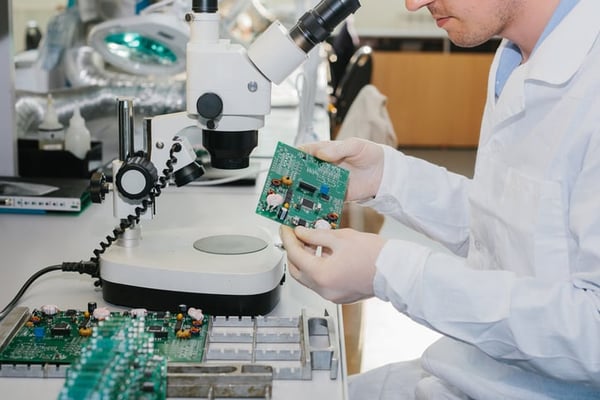Capabilities of an Electronic Manufacturing Services Company
Consolidating services is a great way to reduce costs, lead times, & confusion. Unfortunately, most electronics contract manufacturers (ECMs) don’t...
5 min read
 Matric Group
:
Jun 17, 2022
Matric Group
:
Jun 17, 2022

“How will my idea go from conception to finished product at your company?” It’s a question we hear a lot, and a good one. It’s natural to want to know whom you’re dealing with and how far their capabilities extend.
Some manufacturers are simple “board houses” that pump out cheap orders, while others act as single-source suppliers. At Matric, for example, even if your idea is designed on the back of a napkin, we can offer design-for-manufacturing advice; design and assembly of your PCB, and prototype and test until it’s ready for a successful launch.
We’ll walk through the entire supplier-customer process so you know what to expect from an electronics manufacturing services company.
This is what concurrent engineering and design for the manufacture of electronics products should look for in an ECM (electronics contract manufacturer):
There’s also a hidden eighth capability we’ll get to at the end. But let’s start with #1:
The first things you should discuss with your electronics contract manufacturer discuss are the critical basics. What is the goal for your project? What high-level needs do you have for your ECM?
Some customers want to see the contractor’s facility to check out the equipment and capabilities in person. Others want assurance that the manufacturer has trusted IP protection practices.
You should be asking anything and everything -- your ECM should be, too -- to make sure the partnership is a good fit.
If you decide to continue talks with an electronics manufacturing services company, it should ask for a feature list next.
Providing the ECM with an overall description of your project helps it understand what kind of design, assembly, and testing considerations are in order. This list doesn’t necessarily need to be a straight-specification document yet, but we’ll at least want to know all of your project’s “sellable” features.
This is also the time to tell the ECM you’re looking to move a current product to a new generation. Or maybe you want to convert from through-hole to surface mount technology. Any worthy ECM will act as a guide for these changes to happen smoothly.
Now it’s the electronics manufacturer’s turn to do the heavy lifting.
Your ECM should dive into the component composition on your board to see what’s obsolete or nearing obsoletion. Any red flags must be brought to your attention so you’re not left with a shortage of usable components.
On a related note, the ECM should also research similar products already on the market. Sometimes designers believe they have the next light bulb or microwave oven when in reality 20 other companies are already executing that idea.
Eventually, the ECM rounds up all these components and design features and takes them into account:
To bridge any gaps and help finalize your vision, the ECM may require conference calls or even face-to-face meetings. Finally, its engineers will generate a diagram to gauge whether your visions are aligned.
 4. Providing a Quote for Engineering
4. Providing a Quote for EngineeringThe ECM will generate a quote based on the engineering list and how it interprets the requirements of the job.
The quote breaks the project into phases:
It’s in the best interest of both OEM and contractor to prioritize accuracy from the beginning. You can accelerate the quoting process by giving the ECM everything it needs from the get-go:
You should check with your ECM, and vice versa, to prevent unnecessary holdups.
Steps 5 and 6 go more smoothly if your PCB assembly company is also a PCB design company. A company with experienced design engineers on staff will make sure your PCB layout follows design-for-manufacturability best practices.
Either way, this step will also hit a roadblock if you don’t provide the electronics contract manufacturer with a few things first:
On the ECM’s end, it’s tasked with getting you a true cost assessment of the product. This is pretty much the point of no return -- you can either start a partnership with the ECM or leave it at the altar.
In this stage, your surface-mount technology (SMT) PCB assembly supplier starts the real work. The engineers will lay out the SMT circuit board assembly and enclosures (or use through-hole technology in some cases).
Before going all-out, the supplier should pump out some prototypes, usually five or so. (One is not enough to gauge success; 10 can be a bummer to fix.)
Your newfound partner should test the prototype against your requirements document. This may not guarantee that your product does what it should, but it does guarantee it meets your specs.
Don’t worry -- during this step, we do in fact verify that your product works as intended.
There could also be regulatory steps (UL testing, CE marketing testing, etc.) your ECM must follow here to keep your product legit. Your industry often dictates the level of testing you need -- electronic medical devices, for example, are highly regulated.
Occasionally, customers have to handle this step themselves if the contract manufacturer doesn’t have the test they need in-house.
In other instances, the contractor will hand the final designed product to them as the first article of inspection (FAI). A first article inspection documents and certifies the accuracy of every facet of your product.
The ECM and the customer collaborate (hopefully) on an FAI, but here are six steps that can make it less painful:
Want more information about our testing, inspection, compliance, or standards? Check out our free guide below that covers how an experience ECM should handle everything from UL standards to conflict materials:
This all but completes the electronics manufacturing process. But what about after your product goes to market?
A true all-in-one electronics manufacturer offers aftermarket services to ensure the long-term success of your project. These include but are not limited to:
Working with a supplier who offers aftermarket help is great for legacy products that require sustaining engineering. Some ECMs provide aftermarket services even for products manufactured elsewhere.
Hopefully, you can now visualize how a successful OEM-ECM partnership works. If you have any other questions or concerns about new product introduction manufacturing, let us know.
We specialize in just about every step of the production process, so if you want to see whether our equipment, certifications, and capabilities are a fit for your needs, grab a free e-brochure below:
(Editor's Note: This blog was originally published in September 2019 and was updated in June 2022.)

Consolidating services is a great way to reduce costs, lead times, & confusion. Unfortunately, most electronics contract manufacturers (ECMs) don’t...

There are many areas in life where accepting mistakes as inevitable is a good thing -- electronics manufacturing is not one of them. The end goal...

There’s a certain need for speed in manufacturing circuit boards -- the electronics industry demands it, and your end users demand it. But how quick...